|
SpaceTides e-zine
#50 – December 2006
Internet
Newsletter of ASSA Bloemfontein Centre, South
Africa, to the public
www.assabfn.co.za/spacetides

|
Subscribe to the free SpaceTides e-zine by
sending an e-mail to spacetides@assabfn.co.za
with the word "Subscribe" in the subject line if you are not
already subscribed. |
In this issue of SpaceTides |
INDEX
1. Spaceflight
news from around the world
- Shuttle Discover set for December launch to the ISS
- Stunning pictures sent back from the Mars
Reconnaissance Orbiter
2.
Astronomy news from around the world
- A special view of supernova remnant N49
- Ancient solar system decoder explained
3. Interesting
space facts: So, you wanna be an astronaut...
4. The Solar System: The Red Planet, Mars
5. Sky Observation log: December 2006 skies
6.
Global Warning: A warming planet: as real as it gets
7. Observatories of the World: Cerro Paranal: Home to ESO's four 8.2
meter telescopes
8. Astronomy in Bloemfontein: Boyden Observatory open evening, 9 December 2006
___________________________________________________________________________________________
Greetings
SpaceTides Subscribers
The holidays are almost upon us: time to grab the binoculars and go out one
evening to watch some stars! It is not necessary to be 500 km from the
nearest city in the middle of the desert - the brighter constellations are
much easier to learn from the city.
There won't be any competitions in this issue as the prizes aren't ready yet!
Watch this space. The next issue won't appear at the start of the year, but
only a few weeks later.
>From this edition of SpaceTides we'll have a new section called
"Global Warning" (yes, there's a reason why it sounds so much like
"Global Warming"!) The concept of climate change is becoming ever
more important and we need to take note. The section will rotate with other
sections.
Geniet die vakansie! Ry veilig en onthou om bietjie na die naglug te kyk.
Gerrit Penning, SpaceTides samesteller
Bloemfontein
, Suid-Afrika
Total subscribers as at 1 December 2006: 721 (+7 from previous
issue #49) |
1. Spaceflight news from around the world |
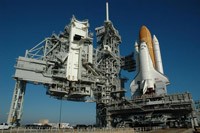
Shuttle Discovery on its launchpad. Credit: NASA. |
Shuttle Discovery set for December
launch to the ISS
From
NASA Space Shuttle pages, December 2006. Go to
website.
Shuttle Discovery is ready to go on the next mission to the International
Space Station (STS-116). Launch is planned for 7 December 2006, although a
launch window exists through December 17. Primary payloads on the 12-day
mission are the P5 integrated truss segment, SPACEHAB single logistics module
and an integrated cargo carrier.
The coming few missions to finish the International Space Station are among
the hardest and most complex. But if you ask the astronauts and
engineers which of the final 14 assembly flights may be the most complex,
many would point to this mission (STS-116) of Discovery. Astronauts
will actually be rewiring the ISS's electrical
system. |
________________________________________________________________________________________
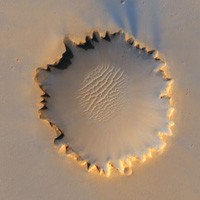
|
Stunning pictures sent back from the MRO
Image
description from Wikipedia. Go to web page with higher resolution
image.
The Mars Reconnaissance Orbiter, the latest satellite to begin an
orbiting career around the Red Planet, has already started sending back some
of the most breathtaking images of Mars. The MRO is equipped with various scientific and photographic equipment.
The image at left was taken by the MRO's HiRISE telescope camera on 3 October 2006. It shows the
Victoria
impact crater at Meridiani Planum, near the equator of
Mars. It is only about 800 meters in diameter, but still you can see
incredible detail.
Since January 2004, the Mars Exploration Rover
Opportunity
has been studying the area
of Meridiani Planum.
Opportunity arrived at the rim of
Victoria
crater 5 days before this image was taken by the MRO.
MRO home page: http://marsprogram.jpl.nasa.gov/mro/technology/ |
________________________________________________________________________________________
Other
News In Spaceflight:
The
Venerable Mars Global Surveyor might be lost
NASA's Mars
Global Surveyor has likely finished its operating career. The satellite
has served the longest and been the most productive of any mission ever sent
to the planet Mars and surpassed all expectations. No communication has
been received from the orbiter since 2 November 2006. One explanation for the
silence is that a solar panel may have jammed, preventing power from being
collected for communication. More at http://www.jpl.nasa.gov/news/news.cfm?release=2006-139 |
2. Astronomy news from around the world |
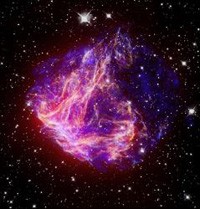
N49. Image credit: NASA and others. See full
list of credits. |
A special view of supernova remnant N49
Spitzer
Space Telescope News Release, 29 November 2006. See full
article.
N49 (pictured at
left) is the brightest supernova remnant in optical light in the Large
Magellanic Cloud. NASA's Great Observatories (3 space telescopes in orbit
around the Earth) - Spitzer, Hubble, and Chandra - have joined forces to
unlock the mysterious structure of this object. Spitzer looks in the
infra-red, Hubble in visible light which our eyes can also see and Chandra observe X-Rays.
To visible-light telescopes, N49 appears to have a unique, lopsided
filamentary structure which has long puzzled scientists because most
supernova remnants appear spherical in shape. Hubble mapped the
visible-light structure, which can be seen as yellow and white in the image,
and Chandra mapped the location of hot gas, which can be seen as blue
in the image. By using Spitzer and Chandra, astronomers have
determined that the funny shape of N49 is being caused by the supernova
remnant expanding into a region of denser gas on one side.
A supernova remnant is the gas and dust structure that formed after a huge
star has exploded. |
________________________________________________________________________________________
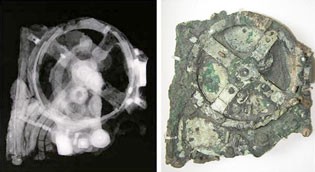
An image showing the
reconstructed device.
Picture: AFP/Getty Images |
Ancient
solar system decoder explained
News
story from Scotsman.com, 30 November 2006. Full article.
A 2,200-year-old astronomical "calculator" invented by the Ancient
Greeks has been reconstructed for the first time, showing they were able to
predict eclipses of the Sun and Moon accurately.
The "Antikythera mechanism", which dates
back to the second century BC, were found by divers
exploring a wrecked ship in 1901.
Researchers only now found out what exactly this device does. By using
imaging techniques to peer into its insides, they created a model of how the
device might have looked like and also how it worked. The calculator
was able to track astronomical movements very accurately, following the Sun
through the Zodiac, predicting eclipses and even recreating the irregular
orbit of the Moon. The findings suggest it might also have predicted the
positions of some or all of the planets. |
3. Interesting Space Facts |

Astronaut
in action. Credit: NASA |
So, you wanna be an astronaut...
As of September 2006 over 450 humans have ventured into space. Compared to
6.5 billion people currently on Earth, that isn't a lot. To become a NASA
astronaut will require some dedication on your part and also a fair amount of
determination:
- of the average of 4 015 applications at NASA each two-year period, 100 is
interviewed and screened. 20 are actually chosen…
- if
you are interested in a pilot/commander position, instead of mission
specialist, you will also be required to log in at least 1,000 hours of
flight time in command of a jet aircraft.
- expect vigorous and very long training. Being and astronaut can be hard on
family life.
- the novice astronauts are given a full range of basic science and technical
courses, including mathematics, Earth resources, meteorology, guidance and
navigation, astronomy, physics and computer sciences. Note that these are not the advanced courses... NASA Astronaut info. |
4. The Solar System: Earth |
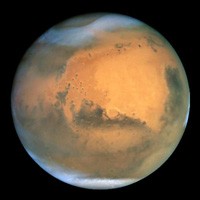
Mars, photographed by the Hubble
Space Telescope. Credit: NASA and
The Hubble Heritage Team (STScI/AURA) J. Bell (
Cornell
U.
). |
The
Red Planet, Mars
Certainly the most mysterious and intriguing planet of them all, Mars is the
4th planet from the Sun. You will be able to walk on Mars, but only in
a space suit. The planet has a thin atmosphere composed mostly of
carbon dioxide and the average temperature is -60°C, with a maximum of 20°C.
One mystery concerns the presence of water ice and the fact that the Mars
Rovers found mineral substances which could only have formed in the presence
of water. Mars also has two polar caps, composed of solid carbon
dioxide ('dry ice') and water ice. Lakes and shallow seas might have
existed on Mars many millions of years ago.
Was there ever life on Mars? No proof has yet been found - we will probably
have to send geologists there or invest intensively in sample-return missions
for a definite answer.
The image at the right displays Mars's two tiny moons, Phobos and Deimos, probably
captured asteroids. (NASA) |
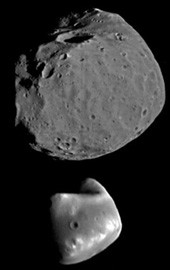
|
This is the 5th part in a 12-part series about the Solar
System.
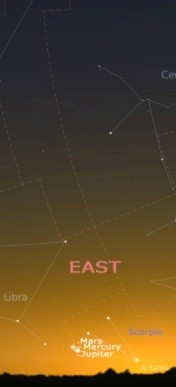
|
Planets
- December
2006
Mercury is visible in the mornings for
the first 3 weeks. Venus becomes the "evening star", visible after sunset in the west. Mars becomes a morning object
from mid-month. Jupiter also becomes a morning object, pairing up with Mars and Mercury to form
exquisite views. Look for the trio before sunrise on the mornings of 8 to 13
December (with 10 December being the best). Don't worry, nothing strange will happen because of this "planetary alignment".
Your microwave won't explode and your hair won't turn a different
colour! The beautiful ringed planet Saturn is visible in the constellation of Leo rising
shortly before midnight in the east.
Constellations - December 2006
With the
holidays, what a great time to look at the constellations of the
summer! Go outside one evening during and explore the night skies... Download
Stellarium from www.stellarium.org and find the positions of the stars and constellations. You will see
Orion the hunter, Taurus the bull and Canis Major the greater dog. Take
a binocular and scan the skies: lift your gaze towards the Seven Sisters
(Pleiades), the Hyades star cluster in Taurus and the Great Orion Nebula in
the sword of Orion.
Jy kan ook 'n konstellasie en sterre vakansiegids aflaai wat deur ASSA Bloemfontein saamgestel is, met meer inligting oor wat sigbaar is in die somerlug oor die vakansietyd.
Other night
sky events - December 2006
8-13 Dec -
Mercury, Mars and Jupiter very close together as seen from Earth
14 Dec - Geminid meteor shower peaks
15 Dec - Spica 0.7 deg N of Moon
19 Dec - Antares occulted by the Moon
Full moon: 5 December 2006
New moon: 20 December 2006
Image left: (Stellarium.org) The eastern horizon
just before sunrise on the morning of
December 10, 2006, at 4h30. Not to be missed! Moet dit nie misloop nie! |
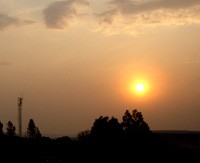
|
A warming planet: as real as it gets
Global warming is real. It's man-made and if we carry on as we do,
catastrophic climate change will ensue. As noted in an article in the
Newsweek Magazine of 4 December 2006, no country challenged this consensus
during the 12th annual UN Conference on Climate Change.
It is time that we start to take note of the consequences of climate change.
Even though the developed industrial countries have the biggest impact, there
are many developing countries (including
South Africa
) which is set to rise in economic prominence. Other such
countries include
India
,
China
and
Brazil
. With economic progress
comes higher environmental responsibility as resources of whatever kind
becomes the target of ambitious exploitation.
Will we be able to present a livable Earth to our children, or will they have
to dig tunnels beneath the ground to survive? |
7. Observatories of the World |
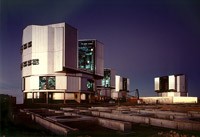
|
Cerro Paranal: Home to ESO's four 8.2 meter telescopes
The European Southern Observatory's Very Large
Telescope (VLT) at the Paranal Observatory
(in the Atacama desert,
Chile
) is for all practical
purposes the world's strongest and most advanced
optical telescope. It comprises four 8.2-m reflecting telescopes and
several moving 1.8-m Auxiliary Telescopes to form a light-gathering "interferometer".
The VLT produces extremely sharp images and can record light from the
faintest and most remote objects in the Universe. Cerro Paranal is a 2,635-m high mountain, 12 km inland from the
Pacific
Coast
.
In 2006 there were 11 instruments including 2 interferometric instruments available for scientific observations.
Homepage: http://www.eso.org/paranal/ Photo at right: Domes at Paranal (Credit: ESO) |
8. Astronomy in
Bloemfontein
|
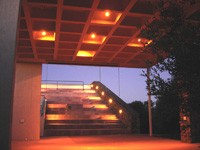
|
Boyden
Open Evening: 9 December 2006 (Saturday)
Time: 18h30 for 19h00 (come early for parking)
Cost: R30 per vehicle
Theme: "The New Solar System" by Gerrit Penning of ASSA
Bloemfontein Centre. Our ideas of the size of the solar
system has changed somewhat since you've been in school...
Telescope viewing and constellation and star watching. Special activity for children "make your own
planisphere". The ideal summer vacation outing for the family! The
evening will go ahead even if it is cloudy.
Reservations: Please phone 051-401 2322 to reserve your seats. |
|



